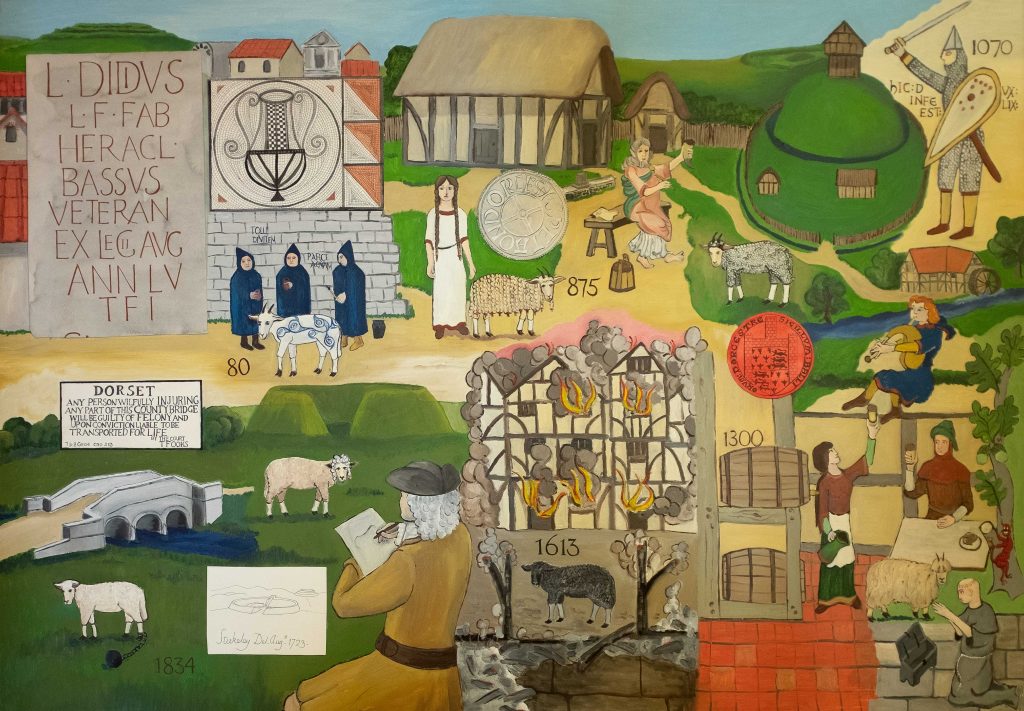Musings of the Artist John Walker.
DORCHESTER
I have freely adapted some incidents from Dorchester’s history to accord with the Raddle ethos of hedonism and sheep. I’ve largely made up the appearance of the early town, because no one knows what it really looked like, drawn on numerous sources for the characters depicted and used a lot of imagination.
THE ROMAN TOWN
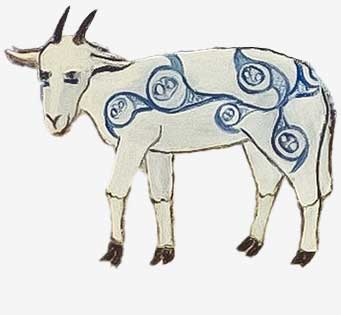
Having turfed the natives out of their uncivilized huts on Maiden Castle the Romans offered them all sorts of amenities (see The Life of Brian for ‘What the Romans did for us’) in the new town along with new taxes. Lucius Didius Bassus, an army veteran, is the earliest Dorchester resident whose name is known. He lived here in retirement, starting a trend that persists in our own day.
The town had a flourishing tessellated pavement workshop and a common motif was the wine-mixing vessel shown here. This and a vessel found in Durngate Street with the inscription Parce Aquam, ‘Spare the Water’, would seem to indicate that the town’s earliest inhabitants liked a drink, thus starting another tradition. The three hooded figures, Cuculatii, are depicted in several Romano-British sculptures but are of unknown significance. Here they are committing grafitto-vandalism (still practised). The newly-shorn sheep has joined the protesters by adopting warrior-style woad body-paint.
SAXONS
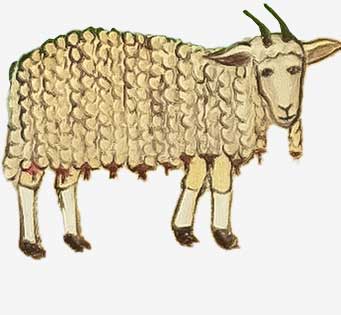
Life continued within the Roman walls and the place had a mint where Speta the moneyer struck the silver penny. New citizens arrived from Frisia bringing new language which developed into the Dorset dialect. Apart from the locals, almost no one else could understand this until the publication of Barne’s Dictionary in the nineteenth century. Unintelligible gibber with uncouth vowel sounds can still be heard in the Raddle today.
The local correspondent of The Anglo-Saxon Chronicle has taken a break from scribing to enjoy a horn of mead while the sheep has adopted fashionable plaits.
NORMANS

As is well known Dorchester’s twin town of Bayeux has an interesting comic-strip account of William the Bastard’s conquest with fire and the sword. Since, then as now, it was mainly the North of England that was devastated no one minded too much. Dorchester gets a mention in the Doomsday Book but the future turned out to be better than the title suggested. Soon after the conquest a castle was built where the Victorian prison now stands. Both buildings were intended to cow the locals. Not submitting to being cowed the sheep has adopted ring-mail.
MIDDLE AGES
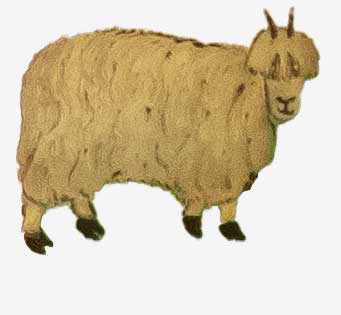
In 1300 the town got a new seal to use on civic documents. Until the Black Death which killed half of the population the townspeople had a good time in the inns and taverns. There were mills on the millstream and a friary whose inhabitants shamelessly preyed on the people but got their just deserts post mortem (see the Summoner’s Tale for details). The sheep has the long-haired look favoured by the Flemish wool-trade. In stark contrast to the money-grabbing friar.
THE FIRE OF 1613

In the seventeenth century the town, sensibly, had a publicly-owned brewery the revenues of which paid for virtually all the civic expenditure. However, it, along with much of the town, was accidently burned in 1613 and it was several days before brewing recommenced on another site. There was one unfortunate fatality, not from the fire but a badly-singed man was assumed to be the arsonist and therefore beaten to death by the mob. The singed sheep has avoided a similar fate.
1723 WILLIAM STUKELEY
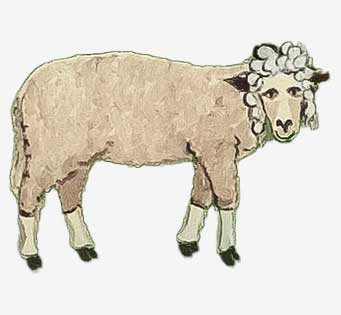
Recognizing that many antiquities were being lost to philistinism, ignorance and neglect (now the remit of the council) the antiquary Stukeley visited the town in 1723 to record as much as he could before it was lost. He was most interested in Maumbury Rings and suggested it was the amphitheatre of the Roman town. The sheep has adopted the fashionable periwig in deference to the distinguished visitor.
1834
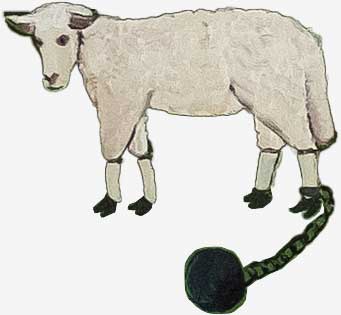
In the Dorchester of Thomas Hardy’s imagination hardly anyone was happy and if they were they knew it wouldn’t last. Sibling-murder, wife-selling, skimmity-riding and cholera were rife, resulting in death or worse, social exclusion. To alleviate this the government introduced a settlement opportunity as advertised on the local bridges, asking not to have your starvation-level wages further reduced was another means of joining the scheme. The sheep is joining the Tolpuddle lads and starting a new life in Australia.
John Walker

